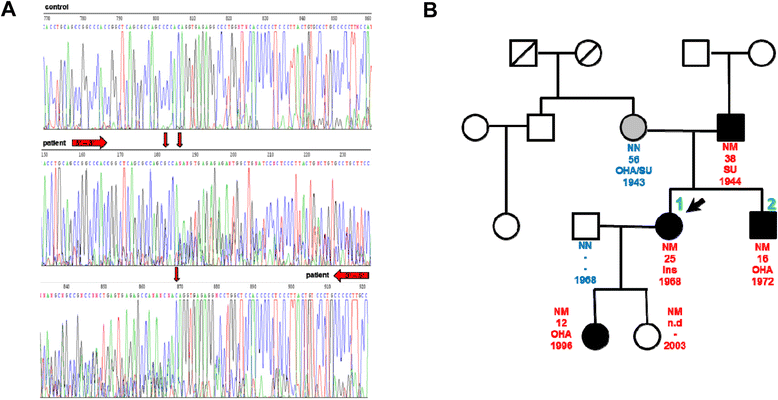Divergent phenotypes in siblings with identical novel mutations in the HNF-1α gene leading to maturity onset diabetes of the young type 3
- PMID: 27142837
- PMCID: PMC4855429
- DOI: 10.1186/s12881-016-0297-z
Divergent phenotypes in siblings with identical novel mutations in the HNF-1α gene leading to maturity onset diabetes of the young type 3
Abstract
Background: Maturity onset diabetes of the young (MODY) is an autosomal dominant form of non-insulin-dependent diabetes mellitus caused by mutations in at least 13 different genes. The hepatocyte nuclear factor (HNF)-1α gene is affected in the most common form (HNF1A-MODY [MODY3]).
Case presentation: We describe the co-inheritance of a novel heterozygous missense mutation c.1761C > G (p.Pro588Ala) with a novel complex deletion insertion mutation (c.1765_1766delinsGCCCGfs86*) in the HNF-1α gene among affected members of one family. Both mutations were present in the affected patients and neither was present in unaffected family members. The family had not only inheritance of MODY but also increased susceptibility to type 2 diabetes. Therefore one family member had classical type 2 diabetes including metabolic syndrome aggravated by a genetic predisposition in the form of HNF1A-MODY.
Conclusion: The presence of common type 2 diabetes features should not detract from the possibility of MODY in patients with a striking autosomal-dominant family history.
Keywords: HNF-1α; HNF1A-MODY; Maturity-onset diabetes of the young; Metabolic challenge; Metabolic syndrome; Phenotype variety.
Figures

Similar articles
-
Co-inheritance of HNF1a and GCK mutations in a family with maturity-onset diabetes of the young (MODY): implications for genetic testing.Clin Endocrinol (Oxf). 2013 Sep;79(3):342-7. doi: 10.1111/cen.12050. Epub 2013 Apr 1. Clin Endocrinol (Oxf). 2013. PMID: 23009393
-
The HNF1A mutant Ala180Val: Clinical challenges in determining causality of a rare HNF1A variant in familial diabetes.Diabetes Res Clin Pract. 2017 Nov;133:142-149. doi: 10.1016/j.diabres.2017.08.001. Epub 2017 Sep 1. Diabetes Res Clin Pract. 2017. PMID: 28934671
-
Genetic and clinical characteristics of Korean maturity-onset diabetes of the young (MODY) patients.Diabetes Res Clin Pract. 2006 Oct;74(1):75-81. doi: 10.1016/j.diabres.2006.03.002. Epub 2006 May 2. Diabetes Res Clin Pract. 2006. PMID: 16632067
-
Hepatocyte nuclear factor 1 alpha (HNF-1 alpha) mutations in maturity-onset diabetes of the young.Hum Mutat. 2000 Nov;16(5):377-85. doi: 10.1002/1098-1004(200011)16:5<377::AID-HUMU1>3.0.CO;2-2. Hum Mutat. 2000. PMID: 11058894 Review.
-
Exploring the role of the HNF-1αG319S polymorphism in β cell failure and youth-onset type 2 diabetes: Lessons from MODY and Hnf-1α-deficient animal models.Biochem Cell Biol. 2015 Oct;93(5):487-94. doi: 10.1139/bcb-2015-0021. Epub 2015 May 6. Biochem Cell Biol. 2015. PMID: 26176428 Review.
Cited by
-
Clinical Characteristics of Patients With HNF1-alpha MODY: A Literature Review and Retrospective Chart Review.Front Endocrinol (Lausanne). 2022 Jun 20;13:900489. doi: 10.3389/fendo.2022.900489. eCollection 2022. Front Endocrinol (Lausanne). 2022. PMID: 35795147 Free PMC article. Review.
-
Molecular mechanisms and genetic regulation in atherosclerosis.Int J Cardiol Heart Vasc. 2018 Sep 25;21:36-44. doi: 10.1016/j.ijcha.2018.09.006. eCollection 2018 Dec. Int J Cardiol Heart Vasc. 2018. PMID: 30276232 Free PMC article. Review.
References
-
- Thanabalasingham G, Pal A, Selwood MP, Dudley C, Fisher K, Bingley PJ, et al. Systematic assessment of etiology in adults with a clinical diagnosis of young-onset type 2 diabetes is a successful strategy for identifying maturity-onset diabetes of the young. Diabetes Care. 2012;35(6):1206–1212. doi: 10.2337/dc11-1243. - DOI - PMC - PubMed
-
- Bellanne-Chantelot C, Levy DJ, Carette C, Saint-Martin C, Riveline JP, Larger E, et al. Clinical characteristics and diagnostic criteria of maturity-onset diabetes of the young (MODY) due to molecular anomalies of the HNF1A gene. J Clin Endocrinol Metab. 2011;96(8):E1346–E1351. doi: 10.1210/jc.2011-0268. - DOI - PubMed
Publication types
MeSH terms
Substances
Supplementary concepts
LinkOut - more resources
Full Text Sources
Other Literature Sources
Medical

